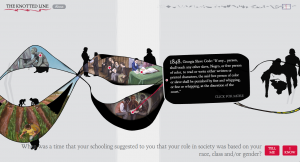
Scalar in use at UCLA Digital Humanities NEH Summer Institute
“Digital Cultural Mapping: Transformative Scholarship and Teaching in the Geospatial Humanities,” the UCLA NEH Summer Institute led by Todd Presner, Diane Favro, and Chris Johanson, is now underway. Many of the summer fellows will use Scalar (along with Hypercities) for constructing their projects. Various members of our team, including Phil Ethington, Micha Cardenas, Craig Dietrich, and Tara McPherson, will participate in some way in the institute.
Visual Culture Scholar Nick Mirzoeff publishes “We Are All Children of Algeria” using Scalar
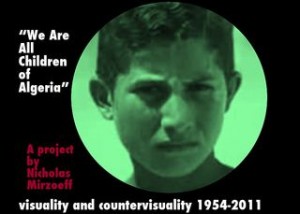 ANVC is excited to partner with Duke University Press in the launch of Nicholas Mirzoeff’s “We Are All Children of Algeria: Visuality and Countervisuality 1954-2011,” a digital extension of his recent book The Right to Look: A Counterhistory of Visuality. Mirzoeff began this project as part of an NEH Summer Institute at USC. In it, he develops and supplements the second half of chapter six of The Right to Look, which looks at cinema in revolutionary Algeria (1954-2011). The piece offers the opportunity to see the films and other visual materials discussed in that chapter and to develop the Algeria connections between the decolonial revolutions of the postwar period and the Arab Spring. For an introduction to the piece, visit the Duke UP blog.
ANVC is excited to partner with Duke University Press in the launch of Nicholas Mirzoeff’s “We Are All Children of Algeria: Visuality and Countervisuality 1954-2011,” a digital extension of his recent book The Right to Look: A Counterhistory of Visuality. Mirzoeff began this project as part of an NEH Summer Institute at USC. In it, he develops and supplements the second half of chapter six of The Right to Look, which looks at cinema in revolutionary Algeria (1954-2011). The piece offers the opportunity to see the films and other visual materials discussed in that chapter and to develop the Algeria connections between the decolonial revolutions of the postwar period and the Arab Spring. For an introduction to the piece, visit the Duke UP blog.
ANVC in full force at the International Association of Visual Culture conference
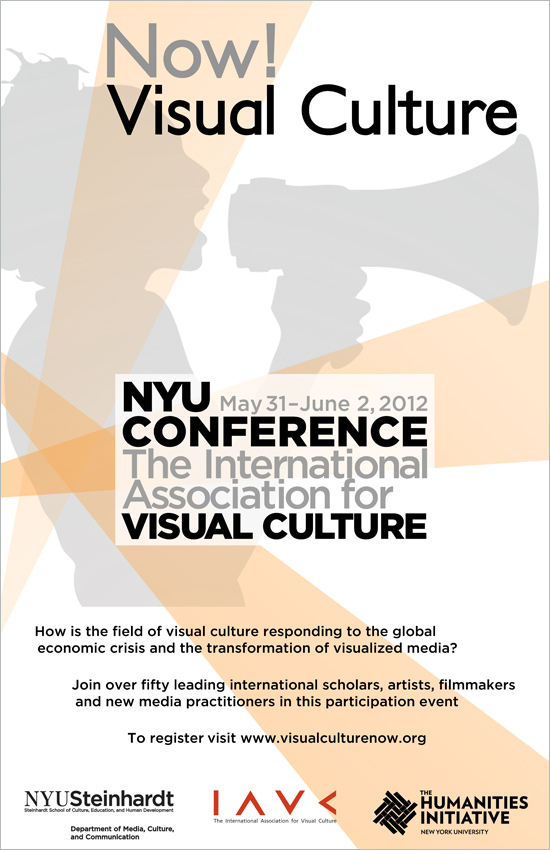 ANVC/Scalar core team members Craig Dietrich, Alexei Taylor and Tara McPherson recently attended the International Association of Visual Culture conference at NYU. “Now! Visual Culture,” a participation event, was held at New York University, May 31-June 2 2012. Its goal was to showcase as broad and diverse a range of visual culture practice as possible in order to create a snapshot of the field of visual culture as it is practiced from Cape Town to California. There was a strong emphasis on the relationship of visual culture to activism, organizing, and protest. Craig, Alexei and Tara led a Scalar workshop and roundtable, while Tara also participated in roundtables on Feminism and Visual Culture and the Future of Publishing. The event marked the live debut of organizer Nicholas Mirzoeff’s Scalar project, We Are All Children of Algeria.
ANVC/Scalar core team members Craig Dietrich, Alexei Taylor and Tara McPherson recently attended the International Association of Visual Culture conference at NYU. “Now! Visual Culture,” a participation event, was held at New York University, May 31-June 2 2012. Its goal was to showcase as broad and diverse a range of visual culture practice as possible in order to create a snapshot of the field of visual culture as it is practiced from Cape Town to California. There was a strong emphasis on the relationship of visual culture to activism, organizing, and protest. Craig, Alexei and Tara led a Scalar workshop and roundtable, while Tara also participated in roundtables on Feminism and Visual Culture and the Future of Publishing. The event marked the live debut of organizer Nicholas Mirzoeff’s Scalar project, We Are All Children of Algeria.
The Knotted Line, a tactile exploration of freedom and confinement, powered by Scalar
Another new Scalar project: The Knotted Line, a tactile laboratory created by artist/educator Evan Bissell that explores the nature of freedom and confinement in the United States. True to its name, The Knotted Line represents the intertwined histories of incarceration, education and labor through a collection of miniature paintings by Bissell depicting over 50 historical moments, all connected by a flowing, interactive line that can be pushed, pulled, and opened to reveal the imagery and content inside. This dynamic interface, designed and developed by ANVC’s creative director Erik Loyer, is almost wholly driven by material authored in Scalar the first project to use Scalar in this way.
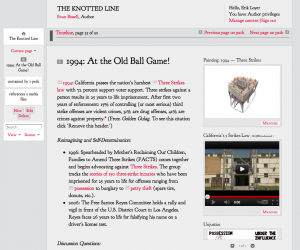
Each painting of The Knotted Line is annotated with brief glosses which introduce the historical event it depicts, and then link to an expanded treatment of the event in Scalar’s native reading interface, featuring embedded videos, images, and resources for educators. The complete timeline, which focuses on the geographical area of the United States, covers over 500 years of history, including some hopeful speculation about future events.
The Knotted Line shows the versatility of Scalar in the way in which it uses the same store of content to drive radically different, yet complementary presentations. Scalar’s ability to add arbitrary metadata using popular ontologies like Dublin Core and ArtSTOR made it possible to include the temporal and spatial coordinates needed by the tactile interface, while still keeping content visible and editable within Scalar’s default presentation.
Because of the visual, pedagogical, and historical nature of its content, The Knotted Line represents a dataset with its own creative potential for remix and reuse. To encourage this, the project’s creators have included a Data Sources path which explains where to find useful resources like 300 dpi versions of each painting, an XML file that defines every point of the knotted line itself, and more a great example of how the open access philosophy behind Scalar enables projects to function simultaneously as publications, websites, archives, and services. As a result, the potential exists to reformat The Knotted Line as a poster, a game, or some unforeseen mashup with another data source; we’re excited by the possibilities.
Scalar-based complement to Matthew Delmont’s The Nicest Kids in Town launches
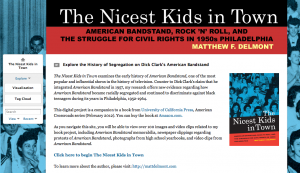 We’re happy to announce that the latest Scalar publication to go live is the digital companion to Matthew Delmont’s new book The Nicest Kids in Town (University of California Press), which explores American Bandstand’s discriminatory policies against black youth in Philadelphia contrary to the claims of host Dick Clark that he integrated the show in its early years. Delmont’s digital project features over 100 images and video clips, including memorabilia, newspaper clippings, and vintage clips from American Bandstand. The Scalar publication first began to take shape at the NEH Institute for Advanced Topics in the Digital Humanities in Summer 2011.
We’re happy to announce that the latest Scalar publication to go live is the digital companion to Matthew Delmont’s new book The Nicest Kids in Town (University of California Press), which explores American Bandstand’s discriminatory policies against black youth in Philadelphia contrary to the claims of host Dick Clark that he integrated the show in its early years. Delmont’s digital project features over 100 images and video clips, including memorabilia, newspaper clippings, and vintage clips from American Bandstand. The Scalar publication first began to take shape at the NEH Institute for Advanced Topics in the Digital Humanities in Summer 2011.
Delmont’s project uses Scalar’s paths feature to organize his material into three main sections: “Bandstand’s Local Years: 1952-1957,†“America’s Bandstand: 1957-1964,†and “Remembering American Bandstand,†each replete with media illustrations. 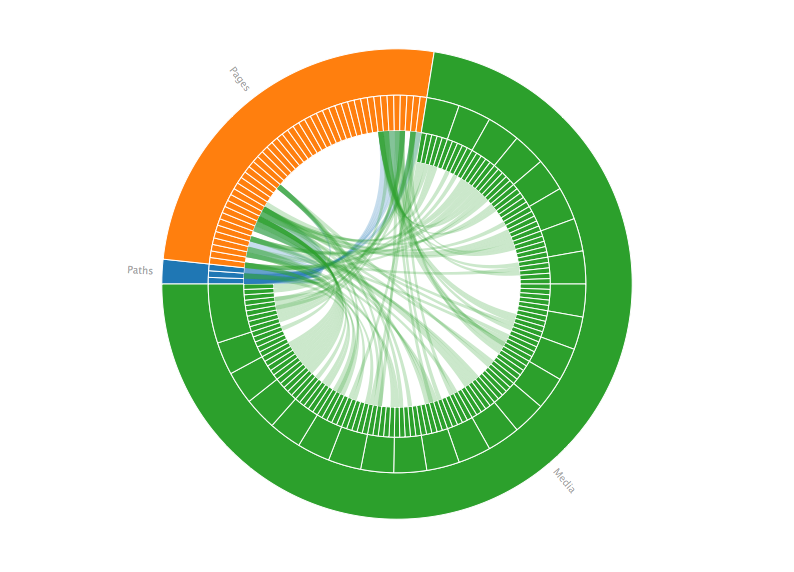 As the screen shot above (taken from one of Scalar’s built-in visualizations) illustrates, media (shown in green) comprises roughly 3/4 of the discrete content elements in the project, and is extensively referenced (media links are represented as green arcs).
As the screen shot above (taken from one of Scalar’s built-in visualizations) illustrates, media (shown in green) comprises roughly 3/4 of the discrete content elements in the project, and is extensively referenced (media links are represented as green arcs).
Delmont recently spoke about his research on Democracy Now! with Amy Goodman and Juan González.
Compatible Data Initiative Highlights Workflows between Archives, Linked Data, and Authors
 Compatible Data Initiative Wordle by Elizabeth Cornell
Compatible Data Initiative Wordle by Elizabeth CornellANVC’s Craig Dietrich joined a group of scientists, humanists, and archivists for a weekend at the New York Public Library to discuss workflows between digital archives, linked data, and authors. At the Compatible Data Initiative conference, Dietrich presented Scalar’s use of XSLT and RDF technology to seemlessly bridge the platform with partner archives including Critical Commons and the Internet Archive. He concluded his talk with a call for publishing platforms to encourage responsible use of media through import features that maintain metadata records and templates that balance voice in both text and image.
Dietrich co-presented with UMaine Still Water co-director Jon Ippolito, who featured the Metaserver, an emerging tool for linking records across archives.
Both Scalar and the Metaserver can point to resources without needing to create a local copy, meaning they can outsource the labor of updating references to the various collections to those curators who are in a better position to do so. And both are free and open-source software. (Still Water blog)

